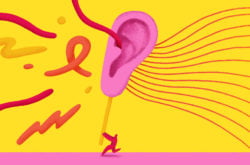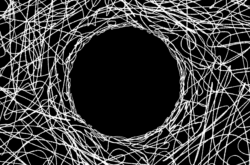You’ve probably heard of white noise, pink noise, or even brown noise before.
Maybe you use white noise in your sound design, or maybe your top song on Spotify in 2018 was “Looped, Loopable Brown Noise” by Sleep Noise Machine, like my mom.
But what exactly do each of these colors mean, and how do they all differ?
White noise
Let’s start with the most straightforward, and probably the most well-known: white noise. White noise is comprised of an equal amount of every frequency, all played at once. It happens in real life when your TV or radio makes static noise. However, because of our ears’ frequency response, we perceive higher frequencies as louder, so it doesn’t sound particularly balanced to most people. Pretty much any other color is basically a slight variation on white noise, based on a rough comparison between the frequency spectrum and the color spectrum. The most obvious and least helpful to know about, black noise, is simply silence.
Pink noise
Pink noise is essentially bass-boosted white noise, where the amplitude decreases as the frequencies get higher. It got its name thanks to the pink / violet hues present at the lowest frequencies of light. This is the perceptually ‘balanced’ white noise that many of us are comfortable with; a lot of ‘white noise machines’ actually play something that’s a lot closer to pink noise. It sounds similar to the rumble of a thunderstorm, and it’s been proven to help people sleep. It’s based on a mathematical curve that can be found everywhere, from DNA to the stock market to traffic jams—but we won’t get into that right now.
Brown noise
Next, brown noise: the only color we’ll be discussing with a name that doesn’t come from the color spectrum (although, some people do call it red noise for that reason). Its namesake is Brownian motion, the term that physicists use to describe the way that particles move randomly through liquids. Brown noise is even bassier than pink noise; while pink noise boosts bass to adjust for human ears, brown noise boosts bass a bit more, just to further warm things up. This noise is similar to the sound of waves crashing or winds roaring, so if you’re a fan of the sea, brown noise might be the noise for you!
Blue noise
Blue noise is, unsurprisingly, the opposite of pink noise. Rather than being bass-boosted, it’s treble-boosted, and the frequencies are so high that most of them are barely even perceptible to us. It sounds pretty similar to the hiss that occurs when you stick your thumb in a hose with running water—a high, screechy tone. Similarly, some people also use violet noise, which has even louder high frequencies than blue noise (violet is to blue as brown is to pink). These aren’t particularly useful for helping you sleep, but they have an important application in audio dithering.
Gray noise
Gray noise is very similar to pink noise, but with one key difference. While pink noise approximates a curve to adjust for all human ears, gray noise is tailored specifically by scientists for each person who uses it. We all share pink noise, but my gray noise isn’t your gray noise. Gray follows a much less general curve, with more specific dips and jumps at certain frequencies, to accommodate one’s unique frequency response. It’s used to treat hearing problems like tinnitus and hyperacusis, and doesn’t have many popular use cases outside of medicine.
The difference between noise types: Conclusion
Depending on who you ask, there are a few other colors of noise with slightly different EQ curves, but they’re all more-or-less based on the colors listed above. Hopefully this article sheds some light for you, and you can now better figure out how to incorporate these noises into your music production (or your sleep schedule)! If you want to play around with the frequencies of some noise, check out this site—just note that the colors don’t quite line up with what we just defined.
Take your music further with the new plugins, fresh sounds, and more available in the Splice Creator plan:
September 16, 2020



